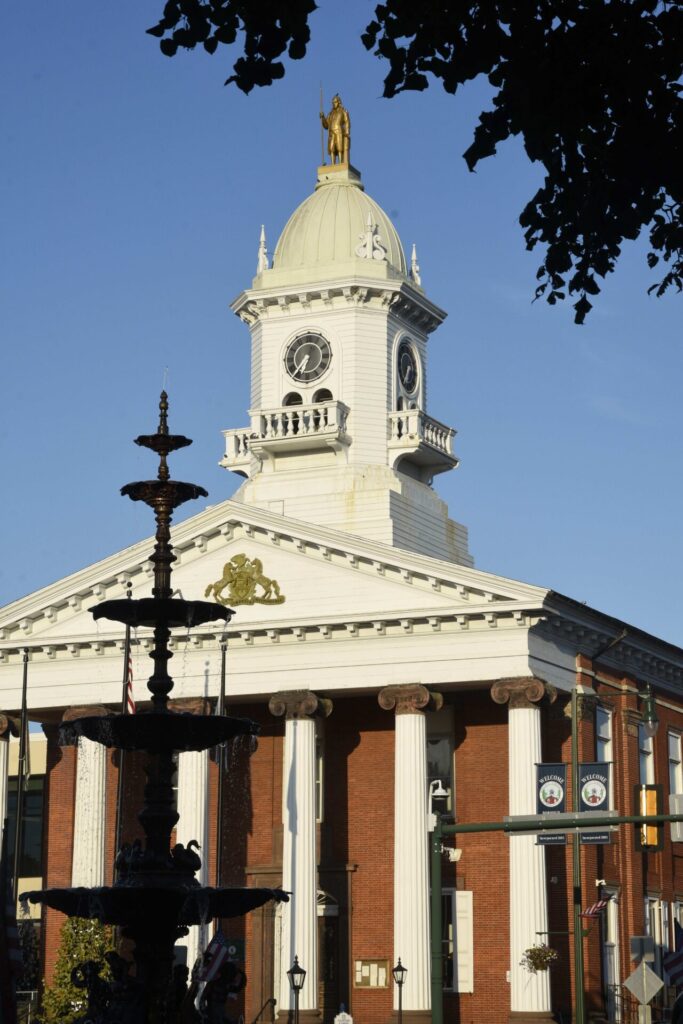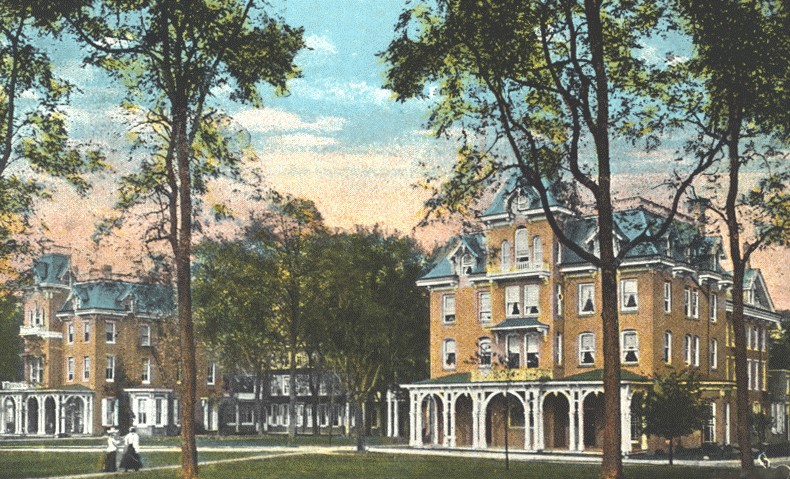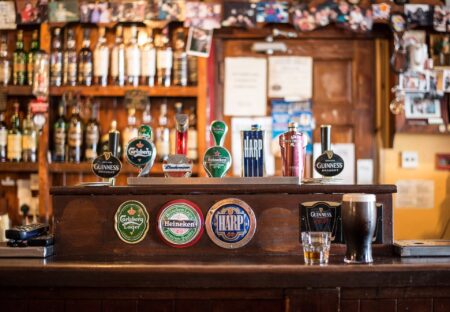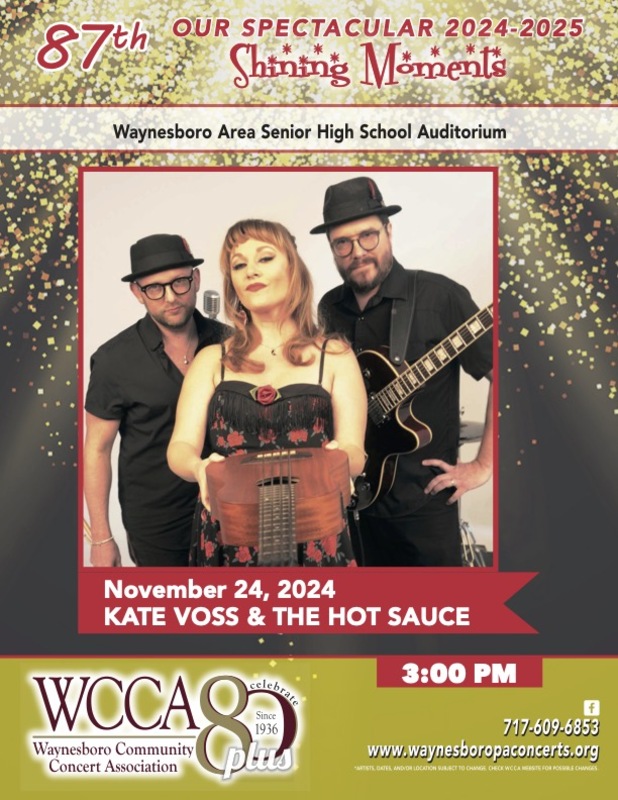Chambersburg is the epicenter of Franklin County historic properties, also serving as its most populous city and seat of county government. The county is rich in National Register of Historic Places sites with an impressive 65 listings, more than neighboring Adams County (35 listings) and Fulton County (eight listings).
Chambersburg was founded in 1730, and during its early history, life in this frontier town was difficult. One of the first structures built was a fort to protect from invasion. The safety and success of local European settlement was uncertain until the French and Indian War ended in 1763.
During the 1800s, this Pennsylvania town prospered, but then Chambersburg suffered a major catastrophe when it was ransomed and burned by Confederates during the Civil War. Devastated but undaunted, the city rebuilt its decimated buildings on a grander scale.
Today, Chambersburg hosts 22,000 residents. The community has a thriving business and entertainment culture, many contained in Chambersburg’s notable architectural venues. Fortunately, some of these buildings survived the disastrous 1864 fire, while others were built during a period of post-war rebirth.
Chambersburg’s nationally recognized historic sites encompass many types of buildings, including government, worship, criminal justice, education, homes and memorials. Many of these architectural gems are located in Chambersburg’s walkable downtown. This central section is designated as a National Historic District, an area with 159 contributing buildings that feature Georgian, Italianate and Queen Anne styles.
Located in Chambersburg’s charming town square, a prominent building on the National Register is the old Franklin County Courthouse. This structure is the third courthouse on the site and replaced the previous one, burned during that Civil War arson. That former building was destroyed, but masonry and pillars from the scorched structure were left standing. Those same bricks and columns were then reused to build an imposing Greek Revival replacement courthouse in 1865.
Courthouses are symbols of democracy and cornerstones of many communities. They are typically placed in the city center and celebrated as gathering spaces. On top of this grand Chambersburg courthouse, a golden statue of Benjamin Franklin presides over the square.
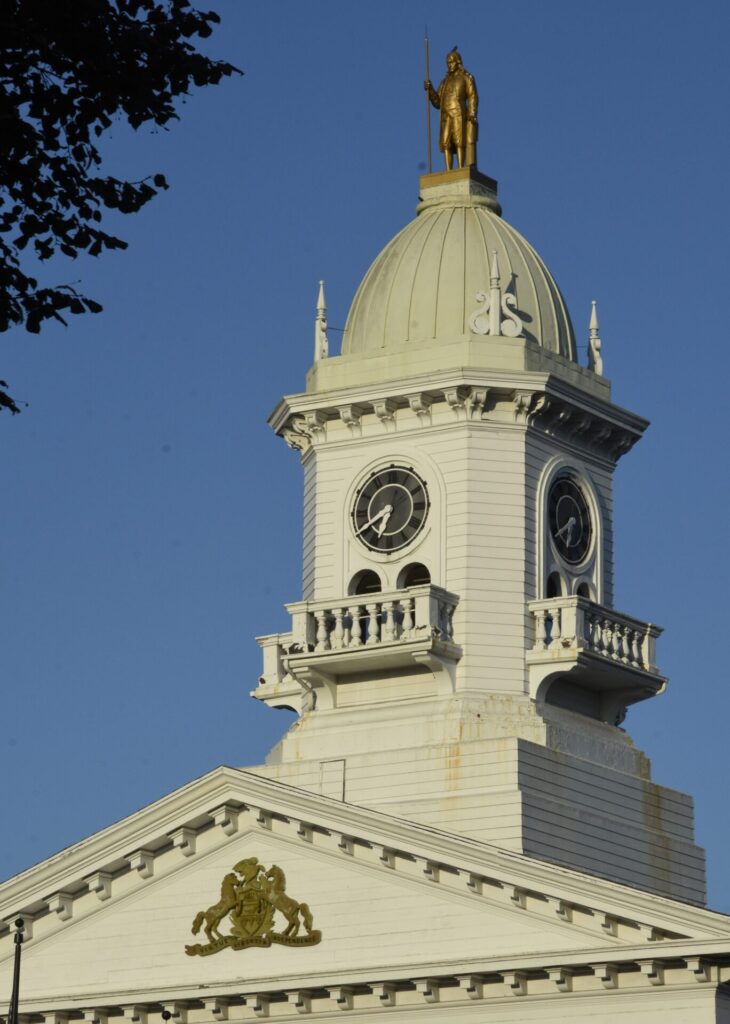
Also in the square, a lovely centerpiece is the Memorial Fountain, a 26-foot-tall cast iron monument dedicated in 1878. This striking feature has a water basin 30 feet in diameter, with eight flower vases positioned around it. At the fountain’s base, four cherubs ride dolphins as water spits from their aquatic mouths. A six-foot statue standing nearby portrays a soldier with a rifle at rest.
This fountain commemorates the town’s post-Civil War rejuvenation. It also serves as an example: National Register sites often recognize other forms, not just buildings. The Memorial Fountain is considered a historic object. The register distinguishes honorees by five separate categories: structures, sites, buildings, districts and objects.
A few blocks north at 55-87 Main St., Townhouse Row is a thriving example of late 19th-century architecture. Featuring adjoining shops, restaurants and residences, these colorful three-story brick townhouses encompass seven buildings, with a common bond at all elevations. While each address reflects unique lifestyles, the connected building’s segmentally arched window heads and bracketed cornices, give a unified rhythm to this lively painted row.
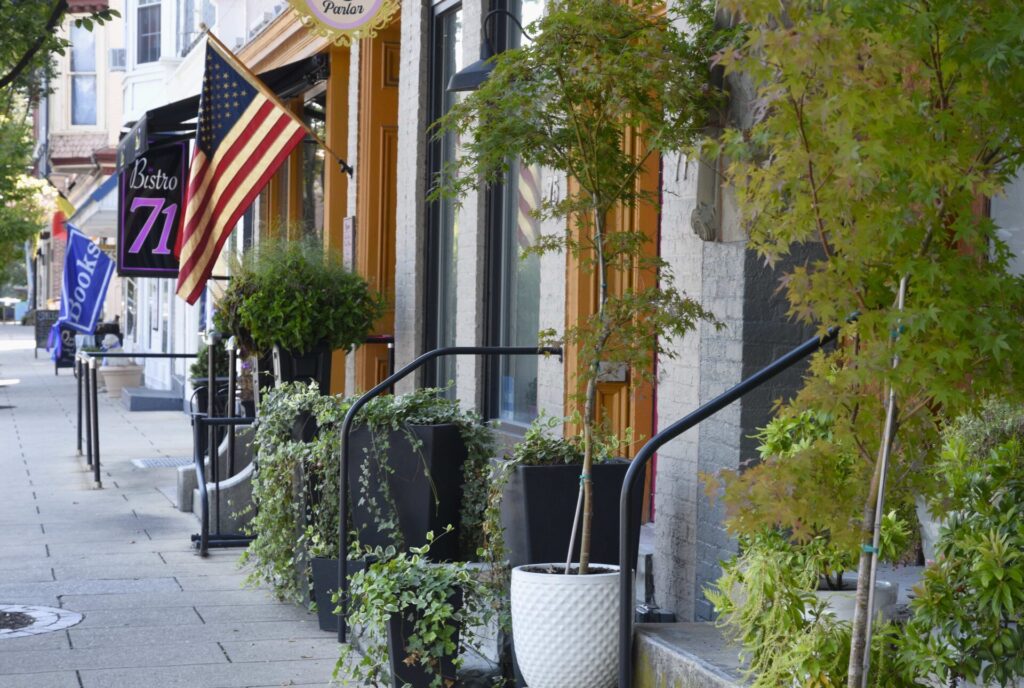
On nearby King Street, a few blocks eastward, two preserved properties highlight the area’s early criminal justice system and recall an infamous character from American history. The Franklin County Historical Society manages these sites and both are available for tours.

The old Franklin County Jail at 175 E. King St. is a fascinating exploration into a bygone era. This building’s regal exterior resembles a courthouse more than a prison. Constructed in 1818, the first clue about its past use are the thick steel bars covering half the building’s exterior windows. The other half of the façade’s windows are uncovered, offering a normal appearance.
Once inside, a tour guide explains this imbalance; the jail imprisoned lawbreakers, confined to the barred-window side. The jailer and his family lived in the opposite section, and their law-abiding status earned them windows free from iron bars. A gigantic ancient key still unlocks the jail’s massive front door.
Outside, 20-foot-tall limestone walls enclose the former prison yard. An old wooden gallows still looms onsite, recalling the county’s last hanging in 1912. The convict was William Reed, executed for killing his lover.
After 152 years in service, this county prison was granted permanent parole and closed in 1970. This building is the oldest surviving jail in Pennsylvania and one of the state’s first National Register honorees.
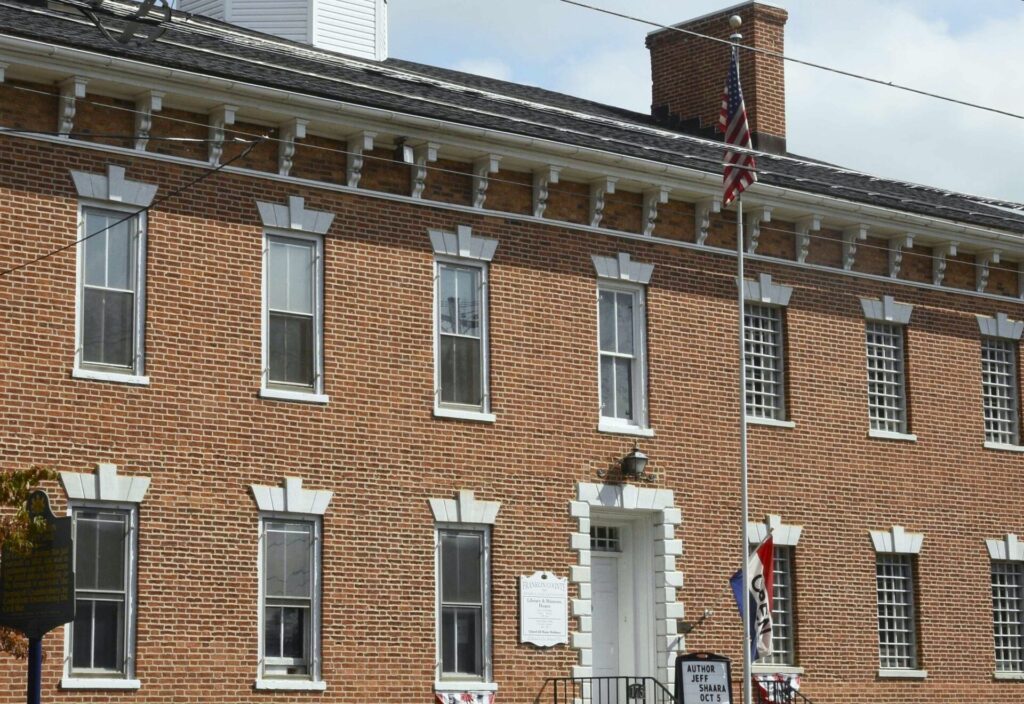
A few doors to the east, the John Brown House, 225 E. King St., is a modest clapboard structure nestled in a block of similar quaint homes. Also known as the Mary Ritner Boarding House, it was formerly owned by a daughter-in-law of Pennsylvania abolitionist Governor Josephy Ritner (in office 1835-39). This Chambersburg house had a famous boarder in 1859. A mystery remains today: Did Mary know this man’s true identity, who used the alias Isaac Smith? Most historians think she did.
That boarder’s real name, of course, was John Brown. Brown came to the area (wanted for murder in Kansas) to plan a surprise raid on the Federal Arsenal at Harpers Ferry, and his plot intended to incite a slave insurrection. This violent attempt failed, and Brown was hanged for treason on Dec. 2, 1859. However, his extreme abolitionist tactics served as a catalyst for the eventual Civil War. Today, some consider John Brown’s legacy a strange paradox between a criminal and a martyr.
The Franklin County Historical Society eventually purchased this house and rededicated it in 2009, the 150th anniversary of John Brown’s raid. Period furnishings decorate the interior and add mid-1850s authenticity to a house tour.
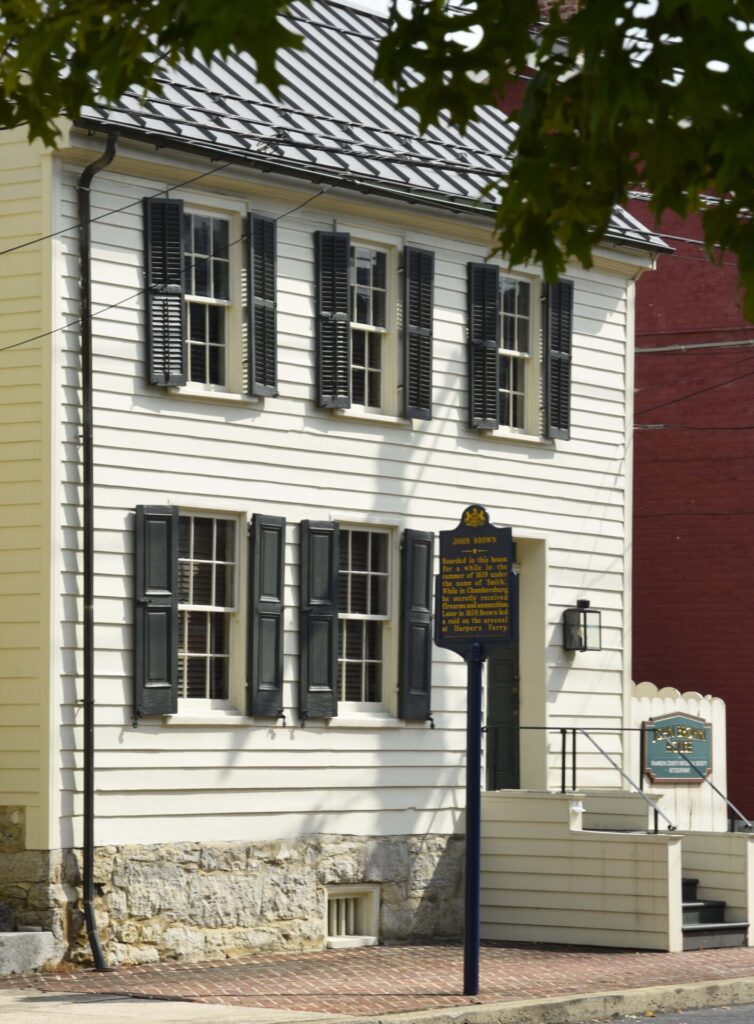
North of downtown, at 1015 Philadelphia Ave., Wilson College is a stately collection of Italianate/Second Empire buildings that still host modern-day students. The school was founded by two Presbyterian ministers in 1869 and named for Sarah Wilson, a pivotal donor during the school’s inception. An early philosophy for the all-female school was developing students who thought for themselves. The founders believed this teaching principle created leaders, not followers.
Today, 1,700 students study a broad curriculum amidst a co-educational environment. The college occupies 300 scenic acres, with serene Conococheague Creek flowing through the campus.
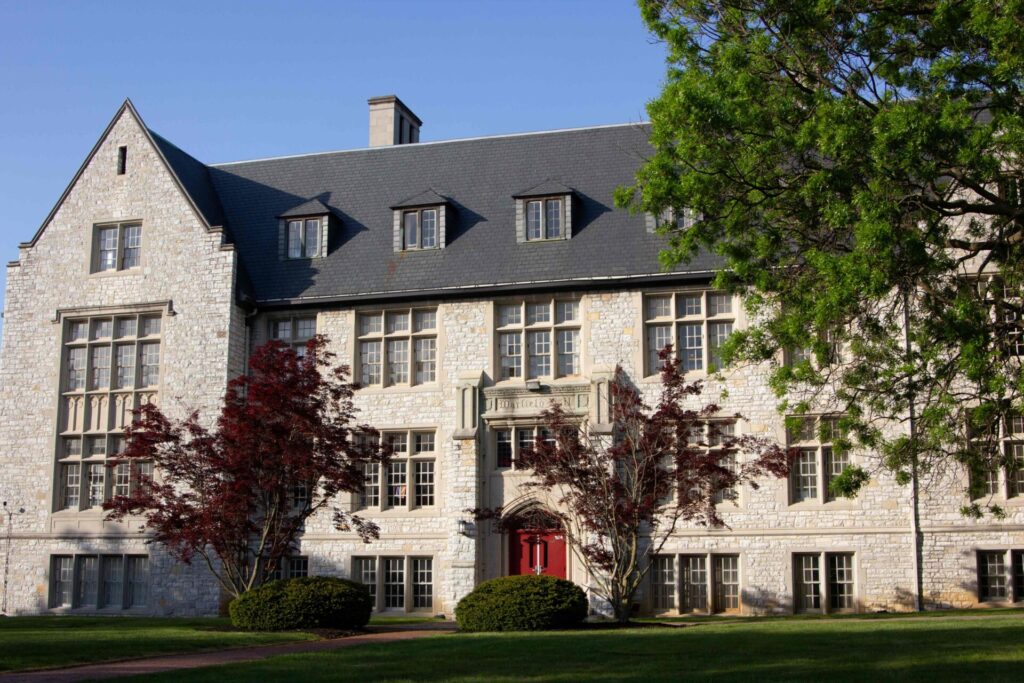
Turning to the town’s faith, Chambersburg’s founder Benjamin Chambers was a devout and generous man. When he settled this burg, he set aside three land parcels for religious buildings. One church was connected to his personal beliefs, named Falling Spring Presbyterian, and another congregation was the First Lutheran Church. While neither church is yet listed as an National Register site, both are historic buildings.
The third property land grant was received by Zion Reformed Church, located at 259 S. Main St. This Georgian-style structure is a National Register site, officially honored in 1979. The congregation affiliates with the United Church of Christ, and completion of this ancient church occurred in 1813.
Zion Reformed has a distinctive bell tower, and tales passed down over centuries describe nervous congregants climbing its steep stairs to scout for approaching rebel soldiers. The church survived and hosted several nationally prominent post-war orators, including Schuyler Colfax in 1867, who became vice president under President Ulysses S. Grant.
These three Chambersburg congregations, with their buildings born from the same benefactor, still celebrate that common bond today. During his lifetime, Chambers requested one unique act to “pay” for perpetual ownership of these religious properties. He asked each church to submit a symbolic rent payment of one rose each year, given to one of his descendants.
Over 250 years later, that touching ritual continues. Each June, this trio of “Rose Rent Churches” pays homage during individual ceremonies as they place a single red rose on Chambers’ gravestone.
Another building with important architectural heritage is the Masonic Temple at 74 S. Second St. Despite the temple reference, this structure served as a meeting lodge for the Fraternity of Free and Accepted Masons, not a place for religious worship. Named for George Washington, a practicing Mason, this Washington Lodge #143 honors the first president. The stylish two-story brick building, with a squared-off upper façade, was built in 1824, and a stucco veneer was added in 1905.
The Masonic Temple survived the 1864 Chambersburg fire, supposedly when a Confederate officer (who was a devoted Mason), ordered the structure spared. Now officially 200 years old, a time capsule is hidden inside this vintage building’s cornerstone.
The most recent addition to the National Register of Historic Places in Franklin County is the Mary B. Sharpe School on Broad Street. The building was designed by Franklin Keagy, one of Chambersburg’s most respected architects during the late 1800s and early 1900s. This sturdy, two-story, red-brick building, built in 1908 and originally called the Broad Street School, is known for its hardwood floors, large windows and high ceilings.
After an addition in 1924, the school was later renamed for Mary B. Sharpe, a civic leader who willed her entire estate to the school district. Sharpe graduated from Wilson College and then traveled overseas to serve during World War I. Back home in Chambersburg, she was known as a kind and charitable woman. Sadly, Sharpe died from burns suffered during a tragic accident while attempting to light her kitchen stove on May 31, 1933.
The Mary B. Sharpe School operated until 2008, then sat vacant for 15 years. Two investors recently bought the building (one attended kindergarten there), and they are restoring it to its former glory, pledging to use original cornices and installing a large cupola.
The conversion of this building into 13 apartments will retain the structure’s historic pedigree. This renovation represents a growing national trend for National Register properties, as many are successfully repurposed and rescued from decay or demolition.
Chambersburg rebounded from the Civil War catastrophe to become a vital community that retains its small-town charm. The city’s architecture adds to this pleasant spirit, and additional National Register listings are found beyond downtown in neighboring townships and rural landscapes.
Many other historic buildings — potential NRHP listings — are sprinkled throughout the Chambersburg area too. After completing a tour, these combined bastions of brick and mortar are reminders that architecture enriches society, and these structures deserve continued recognition and care.
